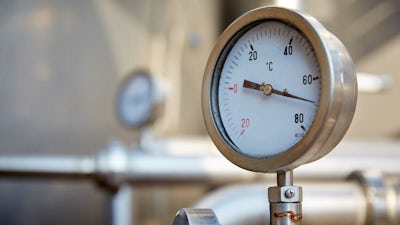Prevent Tank Implosion in Your Brewery During Hot CIP
- Share on Facebook
- Share on LinkedIn
- Share on Email
-
Copy Link
-
Share Link
- Brewing
- March 20, 2020
- 5 Minute Read
- Share on Facebook
- Share on LinkedIn
- Share on Email
-
Copy Link
-
Share Link

The Perfect Polish
Vacuum failure poses a hidden danger in typical brewery operations and can quickly lead to costly mistakes. It can be caused by various factors and can occur during regular tasks such as overfilling a brite tank, using caustic soda in a tank still filled with carbon dioxide, or rinsing a tank with cold water too soon after a hot clean-in-place cycle. Ashton Lewis, Master Brewer-in-Residence for Paul Mueller Company, demonstrates how a tank without proper vacuum relief can be quickly damaged during a hot CIP.
Hot Cycle
To simulate the conditions found inside a fermenter during a hot clean-in-place cycle, Ashton partially fills a 55-gallon drum with water and then heats it to a boil. Once water vapor is visible coming out of the top port, the drum is sealed up. This simulates a tank without a properly sized vacuum relief valve or, even worse, no relief valve at all.
Cold Rinse
Ashton removes the drum from the heat source and sprays it with a hose. This is the equivalent of rinsing a tank with cold water after a hot CIP cycle. The hot steam in the drum condenses into water, greatly lowering the pressure within the drum. The pressure of the atmosphere bearing down on the drum causes rapid vacuum failure and a visually impressive implosion.
How to Prevent Vacuum Failure
A fermenter or brite tank is a significant investment for any brewery. Losing one to vacuum failure can be devastating. That is why it is important to equip your tank with a properly sized vacuum relief valve. Purchasing the right valve can be daunting since no two tanks are engineered the same, and no two breweries use the exact same procedures.
More from Mueller Academy
- Introducing Our New Membrane-Based Water for Injection (WFI) Skids
- Manway Gasket Installation & Bushing Adjustment
- How to Decide Between a Horizontal & Vertical Milk Tank
- MES & PSG Feedwater Quality Requirements
- On-Site Tank Fabrication Under Deadline
- Finding the Right Finish: Understanding Polishing
- Increase the Capacity of Your Clean Utility Equipment
- Balancing a Mueller Multiple Effect Still (MES)
- The Different Types of Steam in Industrial Steam Generation